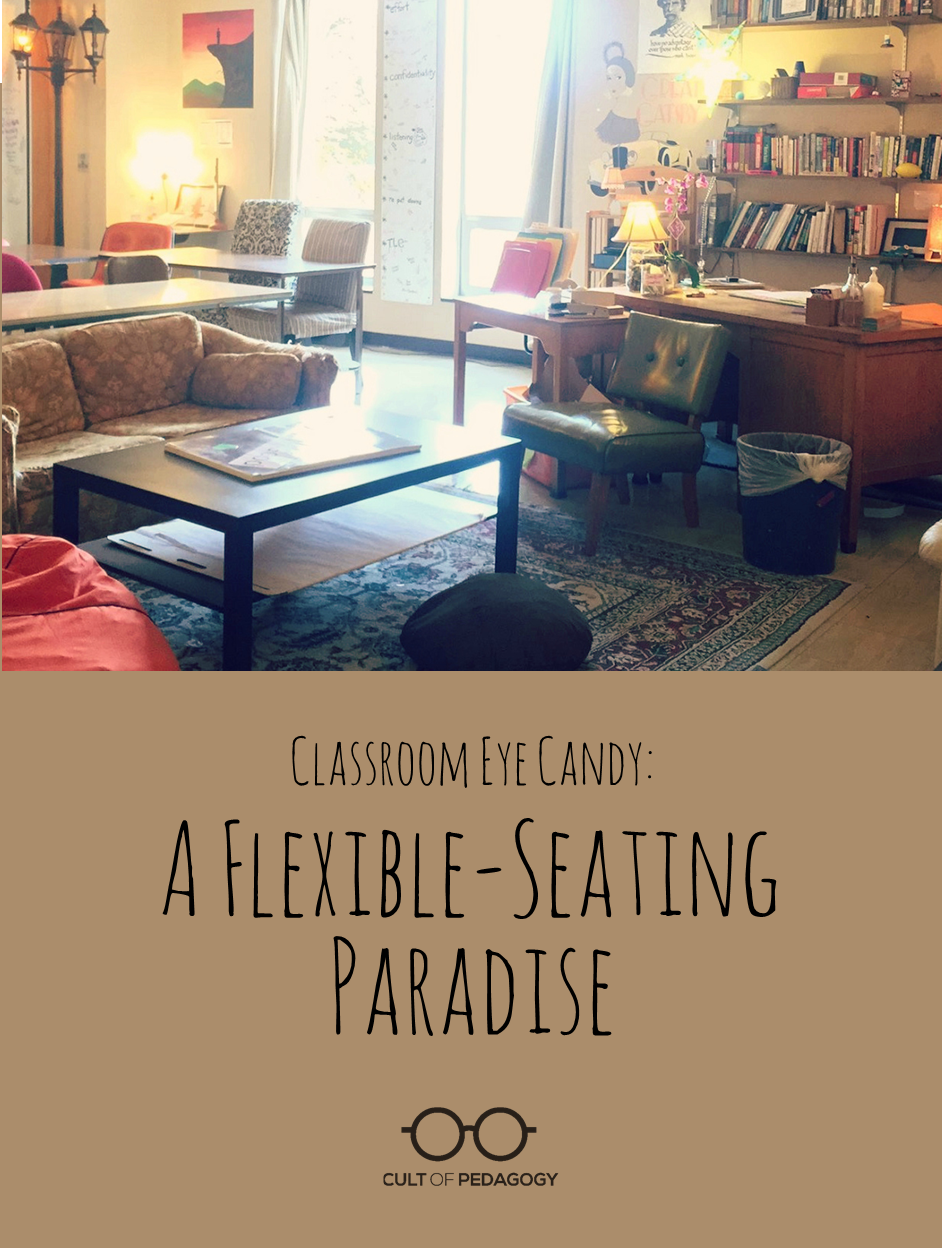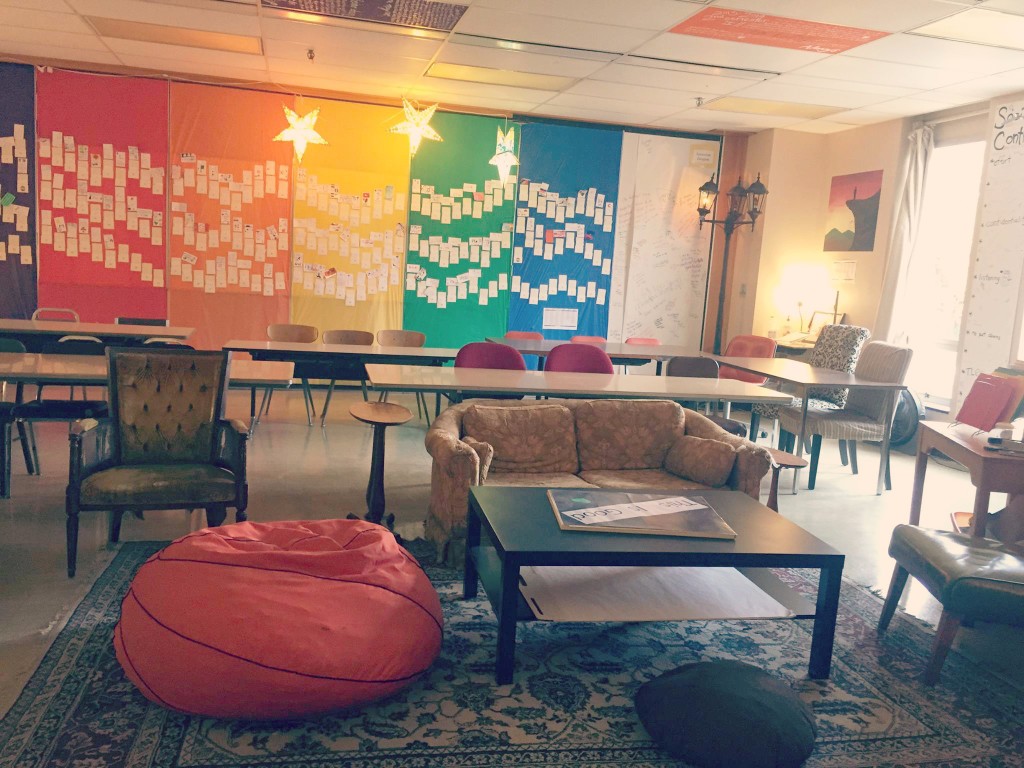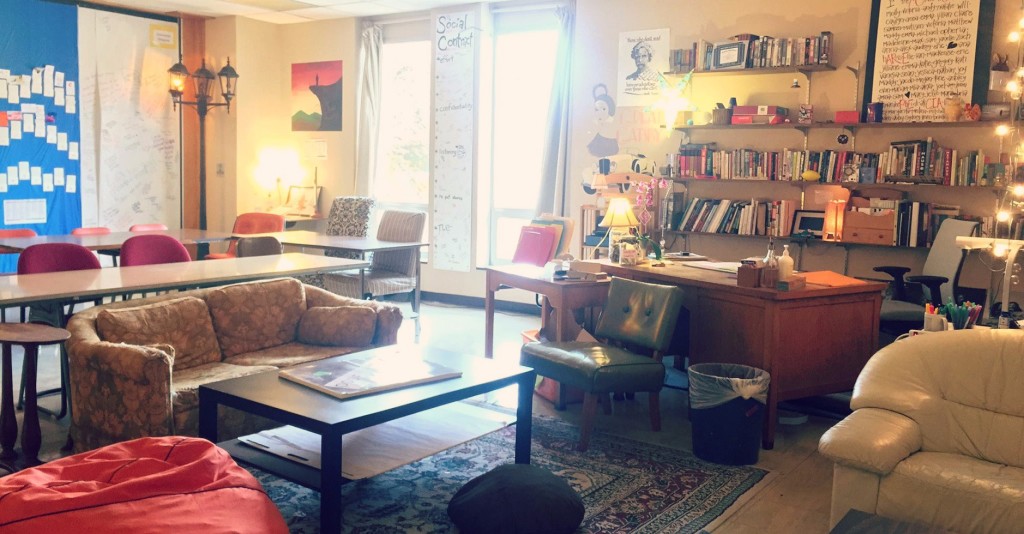Classroom Eye Candy 1: A Flexible-Seating Paradise

Several weeks ago, I posted an article on my Facebook page about student fidgeting and the advantages of flexible seating. One teacher who commented was high school teacher Rebecca Malmquist, who described her own flexible classroom: “I have taken all the conventional desks out and replaced them with mostly tables and a number of different kinds of chairs; I’ve used garage sales and the generosity of friends to furnish my room this way. My classroom looks like a college apartment. But I also build in transitions every 15 minutes or so that require movement (to get into groups, turn something in, write on a paper-covered wall, etc). I have little to no fidgeting problems or issues with attention loss.”
Intrigued, I asked to see a picture. Rebecca obliged, and then I lost my mind: “YOU HAVE THE PRETTIEST CLASSROOM E-VER,” I shouted at her. “I WANT TO BE IN YOUR ROOM!!! I CAN’T STOP YELLING! OKAY, I’M OFFICIALLY STARTING A GALLERY OF BEAUTIFUL CLASSROOM PHOTOS AND YOURS IS GOING TO BE THE FIRST ONE.”
And so Classroom Eye Candy was born.
Classroom Eye Candy will be a feature where I invite you to join me in ogling creative classroom design in any form. We will learn about the teacher behind the classroom and the process he or she used to put it all together. I have no idea when the next one will be or how often I will post these features. All I know for sure is the criteria: I’ll know I’ve found the next classroom when I start writing in all caps.
Classroom Tour
Name: Mrs. Rebecca Malmquist (Twitter @beckymalmquist)
Job Title: High school English teacher – currently English 9 and 10, Creative Writing and Advanced Creative Writing
School Location: Hastings, Michigan
Q: What inspired you to arrange your classroom this way?
A: After my stay-at-home-mom years, as I explored the options of becoming a teacher or a school psychologist, I became an overly qualified paraprofessional for a few years at a school. While there, I noticed a need for teachers who were comfortable teaching all kinds of students. I also noticed that when a student had an accommodation for special seating, or some other really cool environmental thing prescribed by the OT or SLP (etc), they would stick out like a sore thumb. I mean, having a bean bag in your lap to help you feel grounded is awesome, but not if you’re the only one with a bean bag. A chair on wheels that spins? Cool, but not if you’re the only one. You get the idea. So, believing wholeheartedly that people gravitate towards what they need without even having to really think about it, I started noticing (in meetings, at my home, out in public) that most people, if given a choice, choose their spots based on some known or unknown instinct.
I vowed that my future classroom would be a place where those types of sensory needs were normal choices for anyone.
The Details
Seating:
So as long as a student’s postures and movements do not disrupt others’ learning and comfort, they are literally allowed to choose any number of places to land in our classroom. They can be:
- on the floor, carpeted or tile
- over/under a blanket, pillow, or lap-sized bean bags
- on a couch, an easy chair, a Papasan chair, a traditional chair (wood), stools that don’t move (with or without back support), stools that move up and down, “spinny” chairs on wheels, chairs that feel like they may tip (but don’t), chairs that are plush on the seat and/or the back, or a high-backed easy chair
I did get rid of my exercise balls, because they just never held their air … I have a dream for a balloon chair or an inflatable office chair or two (dar Living Balloon Seat), but haven’t acquired any yet.
Tables/Writing Surfaces:
Students can choose from end tables, clipboards, hard place mats, long conference tables, circular tables, rectangular tables, single tables near the teacher’s desk, coffee tables, or the floor.
Manipulatives:
These are kept on my shelves for students to pick up and hold/play with: stress balls, tennis balls, plush animals, noiseless things, hard balls, plastic Slinkies.
Lighting:
No fluorescents—ever. I had a student with autism that could hear them and they would irritate him, which made me notice that I sometimes could get agitated when they are on too long, too. I have natural light in my classroom and a number of different light sources so they can always see well, no matter the time of year or day. Last year I had a student whose mom asked me to place a S.A.D. light in my room for her child, because she figured it would be the best place for the child to get a daily dose (30 min/day) and s/he fit right in when s/he sat in front of it in our classroom.
Music:
I play music every day when they come in for class; the genre changes, to accommodate all the different interests in the room. I think that adds to the environment as well.

Q: Where did you get the materials/furniture?
A: Mostly I find these things at garage sales; I buy them with my own money. I DO work at a school with a basement full of furniture odds and ends that no one wants; if I ask for a piece down there, I get to use it until someone else wants or needs it for something (that is where the cool street lamp comes from: an old prop for some play or dance some years ago). Now that people notice my classroom, I get offers for cool things to add to our classroom, and I take them.
Q: What’s the deal with that rainbow wall in the back?
A: That is my affirmation wall. The colors correspond to class hours; the library card holders have numbers. Each color has 30 library card holders that are numbered. Each student has an address that reads something like this: Red 30; Blue 28. Here’s a link to explain that a little bit more:
https://sites.google.com/site/mrsmalmquist/about-me/affirmation-station
https://m.youtube.com/watch?v=YAblJkJsW8I
If you’re interested in hearing how I actually execute this efficiently for 150+ students after checking out that page, let me know. I’d LOVE it if people tried this with more high school settings; it makes a huge difference in the classroom.
I also have papered walls on which kids can and do write questions or good news (they sign and date these entries). Those are near the rainbow wall in the back.

Q: So how does it work? Do students choose where they want to sit all the time? Is there competition for the “best” seats?
A: I knew I didn’t want to tie it to rewards, but I was afraid everyone would rush to all the sweet spots if I didn’t assign it or have some kind of a procedure for it when I first started teaching, so I used to assign it randomly. I found it wasn’t really necessary, and it didn’t fit with my philosophy for making the environment in the first place. I mean, what if a kid NEEDED an accommodation in seating/lighting, and they always happened to get the couch, or whatever? I also found some people becoming proprietary, even when only assigned a spot every once in awhile, because it became the ever-elusive spot? I’m not sure. So I changed it up.
Now, I start every semester by greeting kids at the door and asking them to find a place in which they feel:
1: Comfortable
2: Capable of doing their best work
And then each day after that, for at least a solid 7-10 school days, I greet them with the same words, but I add this:
3: And it must be new to you. (Right…you cannot have chosen that place yet…yes, I’m serious…no, you can’t pick a place you picked two days ago…)
After that time, it becomes natural for them to pick a handful of different places throughout the room. Every once in awhile, I go through this again if I notice that they are gravitating toward the same spots over and over again. I tell the kids I’m trying to get them to relax enough to learn and to figure out what works best for them; I remind them that what works one day may not work the next day.
Also, if a student chooses a place where s/he is not oriented to the front naturally, it is likely her/his chair is one which has been carefully placed so s/he can spin towards a speaker at any time, and I teach this as expected behavior at the beginning of the term.
People always assume that kids will fall asleep in such a relaxed environment. That’s just not the case. Students tell me that the room is not only relaxing, but also makes them feel cared about and understood.
Q: Have you noticed a difference in how your classroom feels and operates compared to earlier arrangements?
A: No…because I never was a rows and desks person. Maybe that’s not true…I didn’t get the tables until the middle of my first year, so I had desks. Most of the kids hated the desks because they didn’t fit well and felt constrained. No one ever chose them first, that’s for sure. I slowly phased them out. This year, I have no conventional desks at all and I’ve never been asked for them.
Students tend to ask their parents to come visit during high school open houses (this is usually not a hot event for high school age students); I think that says a lot.
I’d like to thank Rebecca for sharing her space with me. I hope it inspires others to find ways to offer students choices for getting comfortable in the classroom. If you know of a classroom that deserves to be featured in Classroom Eye Candy, contact me here.
Want to see more flexible classrooms? Watch this Edutopia video that shows several other flexible classrooms in action: Flexible Classrooms: Providing the Learning Environment that Kids Need
Join my mailing list and get weekly tips, tools, and inspiration — in quick, bite-sized packages — all geared toward making your teaching more effective and fun. To thank you, I’ll send you a free copy of my e-booklet, 20 Ways to Cut Your Grading Time in Half. I look forward to getting to know you better!



